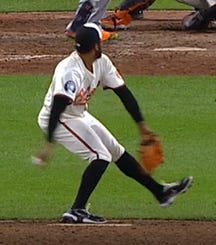Unlocking Dillon Tate
A Deep Dive into Dillon Tate: Analyzing the Factors Hindering His Success and the Key Adjustments That Could Unlock His Full Potential
Opening
With spring training upon us, it's intriguing to look over the remaining free agents that are still readily available for teams. One player who's seemingly grabbed my attention is former 4th overall pick of the Texas Rangers, Dillon Tate. Over 5 years in the majors, he's been able to produce a respectable 4.06 ERA and 3.98 FIP, with his most successful season coming in 22', where he posted a 3.05 ERA and 3.48 FIP. Since that season, Tate has dealt with elbow and forearm injuries that sidelined him for the 23’ season, leading him to be a shell of himself when he returned in 24’ with results of 4.66 ERA and 3.71 FIP. In this season I see a couple of things that signal why this could’ve possibly happened, with the first being a decrease in velocity as well as poorer locations on his pitches.
Dive in
Looking into ways to possibly improve, it's important to understand that Tate is bucketed as a low slot pronator due to limited and slow breaking ball abilities and the ability to get behind the FF at release. Like I mentioned earlier, the main hit on Tate in 24’ was his decrease in velocity. When looking at a year-to-year basis, Tate was able to sit at 95.5 MPH on his sinker in 21’, but in 24’ he could only muster up 92.6 MPH. I believe this could be due to a combination of less efficient mechanics and possibly a hindrance to his injury.
When looking at a year-to-year mechanics comparison, we see that Tate has altered his slightly. The first thing that stands out to me is that he dropped his arm angle from 32 degrees in 21’ to 26 degrees in 22 (still 26 in 24), which, I believe, is a compensatory pattern to achieve his sweeper shape. Prior to the addition of this pitch, Tate was throwing a depthy cutter in which he could play into his more natural plane of rotation. Once he added the sweeper to be able to achieve the shape, he took the compensatory measure of dropping his arm angle to be able to produce the desired shape. The compounding effect of throwing this pitch so much seems to have altered his plane of rotation as a whole and caused a less efficient organization of his body in the delivery. This less efficient movement pattern coincidentally did not help with his velocity dropping from 95.5 MPH to 94.0 MPH from 21’ to 22’. We see the same effects rolling into 24', where Tate still possesses the lower slot and this time only averages 92.6 MPH. Granted, this could be in large part due to his right elbow flexor strain, which kept him out all of 23’, hindering his ability to produce sufficient velocity. Despite this, I think it's evident that Tate was less efficient with his movement in 22’, which have still carried over into 24’. I believe it would be beneficial for Tate to get back to his more natural plane of rotation with a higher slot to allow for a possibility to regain his prior velocity.
To show the effects of how the compensatory pattern spread through his motion is how it hindered the rest of his delivery. As you can see in 22', he's more hunched over at the peak drop phase in his delivery as a compound result of him taking the compensatory measures to achieve said shape. Compare this to 21'; we see how he's much more upright and stacked over his pelvis, allowing for a more efficient transfer of energy throughout the delivery. Taking these measures to achieve a shape has caused him to deviate from his most natural movement pattern. Further pushing the agenda to get Tate back to his prior slot to allow for him to produce his most efficient movement pattern.
Arsenal Dive
With these possible adjustments, it raises the question of whether Tate should continue to throw the sweeper knowing it was most likely the cause of his velocity decrease. Some may be quick to remove this pitch, but I think he should continue to throw this pitch because of how it was a go-to whiff pitch, producing a 36.9% in 22’ and 37.7 in 24’. Taking this pitch away from him would do more harm than good. Knowing this, a reorientation to a two-seam grip could be exactly what Tate is in need of. This would allow for him to still achieve the riding sweeper shape without having to take the compensatory pattern that he had taken prior.
Despite the compensatory pattern to achieve this shape, one main drawback of this sweeper was its inability to draw sufficient chase. Since introducing this pitch, he was only able to draw a 27.9% Chase% in 22’ and 27.6% in 24’, both being below average. Leading me to believe that reimplementing his former cutter (shape: -2.7 iHB and 3.3 iVB) could play as an extremely effective bridge pitch to induce more chase. To add onto this, it was also effective in its own right from his most natural plane of rotation, controlling damage with a .262 xwoBACON and the ability to miss bats with a 34.4 Whiff%; highlighting a possible return of this pitch. Of course, this idea hinges on the role Tate plays for the team he signs with. Still, the addition of this pitch would elevate his arsenal and be a major factor for a team to go out and sign him.
Location of SI
Now the final thing I really want to emphasize with Tate is the location of his sinker. When he was most effective in 22', this pitch was phenomenal, producing a 20-run value, which in large part was due to his location of this pitch. During this season he threw this pitch arm side 48.6%, which is about league average, but is much improved from 21’, where it was only 42.2% and 39.2% in 24’. What's great about this sinker shape is that it's able to produce unexpected arm-side run and depth, making it clear why it was so effective when he pounded it in on righties. Playing into this movement is what I believe Tate should do more consistently. To help with this, a catcher positioning adjustment further in on righties could really mitigate mistakes leaking over the plate like they had prior. With or without the velocity adjustments, if he could make this a more consistent location on the inner third, he could possibly return to the success he had with this pitch in 21’.
Closing Thoughts
Sadly, Tate is still a free agent. He's 30 years old with 5 years of major league experience under his belt with one MiLB option left. I know he hasn't been the most effective thus far in his career, but he's shown signs of above-average velocity that I believe can be unlocked to go along with the low-hanging fruits of arsenal additions and location adjustments that could improve his effectiveness. Tate is a flyer waiting to be grabbed; I just hope someone does.







